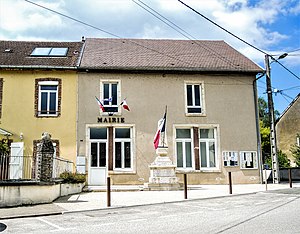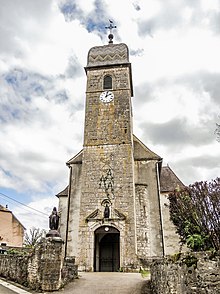Avilley
| Avilley | ||
|---|---|---|

|
|
|
| region | Bourgogne-Franche-Comté | |
| Department | Doubs | |
| Arrondissement | Besançon | |
| Canton | Baume-les-Dames | |
| Community association | Deux Vallées Vertes | |
| Coordinates | 47 ° 26 ' N , 6 ° 16' E | |
| height | 236-295 m | |
| surface | 5.62 km 2 | |
| Residents | 163 (January 1, 2017) | |
| Population density | 29 inhabitants / km 2 | |
| Post Code | 25680 | |
| INSEE code | 25038 | |
 Mairie Avilley |
||
Avilley is a French municipality with 163 inhabitants (as of January 1 2017) in Doubs in the region Bourgogne Franche-Comté .
geography
Avilley is located at 245 m , eleven kilometers northwest of Baume-les-Dames and about 28 km northeast of the city of Besançon (as the crow flies). The village extends along the Crenu brook on the eastern edge of the Ognon valley , in the gently undulating landscape in the far northwest of the Doubs department.
The area of the 5.62 km² municipal area includes a section of the Ognon Valley. The western border runs along the Ognon, which flows here with large river loops through a flat valley that is around one kilometer wide. The Crenu flows below the village and provides drainage for a large part of the municipal soil. It is fed by the two sources Source du Seigneur and Source des Serfs. From the course of the Ognon river, the community area extends eastward over the wide floodplain into a gently undulating landscape on both sides of the Crenu, which is partly made up of arable and meadow land, partly also with forest. In the north is the extensive forest area Bois du Pagre , in which the highest point of Avilley is reached at 295 m.
Neighboring municipalities of Avilley are Montbozon in the north, Montussaint and Tallans in the east, Battenans-les-Mines and Cendrey in the south and Ollans , Maussans and Besnans in the west.
history
Various finds indicate that the municipality of Avilley was already settled during the Gallo-Roman period. Since the 12th century Avilley formed a rule that experienced numerous changes of ownership until the French Revolution . Together with Franche-Comté, the village finally came to France with the Peace of Nijmegen in 1678. The medieval castle was rebuilt in 1775, but destroyed again in 1793.
Attractions
The Saint-Symphorien church was rebuilt from 1727 to 1729 on the site of a previous building. Some traditional farmhouses from the 18th and 19th centuries have been preserved in the town center. There is an early 19th century mill at the Ognon.
population
| Population development | |
|---|---|
| year | Residents |
| 1962 | 128 |
| 1968 | 165 |
| 1975 | 134 |
| 1982 | 139 |
| 1990 | 114 |
| 1999 | 135 |
| 2016 | 166 |
With 163 inhabitants (as of January 1, 2017) Avilley is one of the small communities in the Doubs department. After the population had declined markedly in the first half of the 20th century (318 people were still counted in 1886), slight population growth has been recorded again since the beginning of the 1990s.
Economy and Infrastructure
Until well into the 20th century, Avilley was predominantly a village characterized by agriculture (arable farming, fruit growing and cattle breeding) and forestry. The hydropower of the Ognon was used early on to operate mills. A brick factory was also located in Avilley. Today there are various local small business and retail businesses. In the meantime, the village has also turned into a residential community. Many workers are therefore commuters who go to work in the Besançon agglomeration.
The place is off the main thoroughfares on a departmental road that leads from Besançon to Rougemont . The closest connection to the A36 motorway is around 17 kilometers away. Further road connections exist with Maussans and Mésandans.
literature
- Le Patrimoine des Communes du Doubs. Volume 2, Flohic Editions, Paris 2001, ISBN 2-84234-087-6 , pp. 1094-1095.

